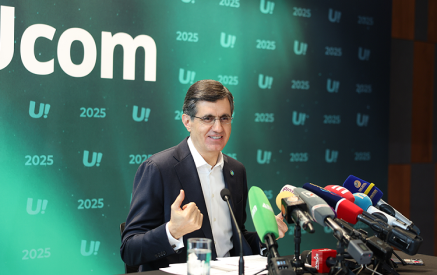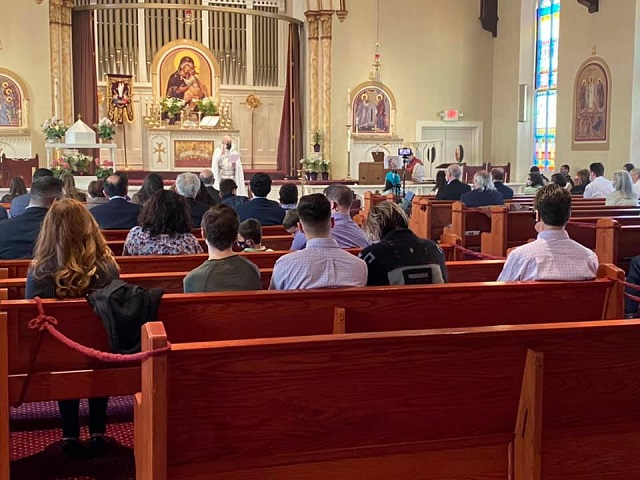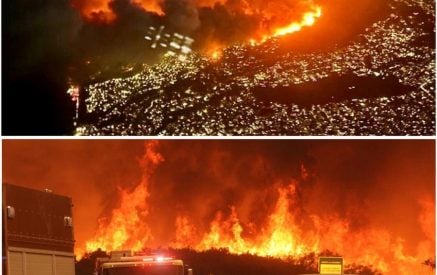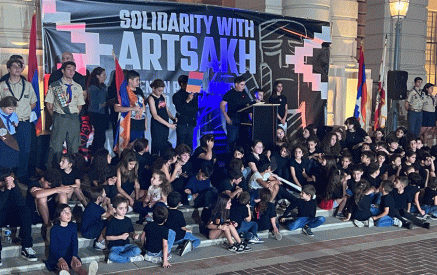With the celebration of Easter Sunday this past week, the season of Eastertide opens for the Christian community. This time is particularly focused on the Resurrection of Jesus Christ and its impact. During the weeks after Easter, we experience the Ascension, which remembers Jesus’ ascent into heaven on the 40th day after His Resurrection, as well as Pentecost, which remembers the descent of the Holy Spirit onto the disciples and others. This took place on the seventh Sunday after Easter (50 days) and represents the beginning of the Christian church. For the faithful, the period from Palm Sunday until Pentecost gifts us much of the theology, rituals and remembrances of our faith.
The Easter season has always been a special time in the Armenian community. I remember in my youth a friend of mine asking our priest (the rest of us were too shy) why the crosses in the Armenian church do not show the Crucifixion. Our priest explained that the Armenian church has always emphasized the importance of the Resurrection in its teaching. He stressed that, of course, His sacrifice on the cross is important, but the defeat of death and the emergence of eternity are the foundation of our church. I always retained these small nuances as they helped build my Armenian identity.
Easter was always socially special as my parents would either host our extended family or we would be at one of our relatives’ homes. A few weeks before Easter, my parents would take me to a local clothier to buy an Easter “outfit,” which usually consisted of a new sports jacket and pants, accessorized with a bow tie. Before my teen years, my parents liked to dress me with a fedora-type hat for the day. Thankfully they granted me some freedom of choice as a teenager. We always arrived early at church, because my father was the deacon and my mother taught Sunday School. The downstairs on Easter Sunday was not set up with the typical classroom sectionals. The hall was set up for a community gathering. I loved the Easter Badarak because you could feel the excitement and joy in the sanctuary. Perhaps it was because there always was a large crowd and people were happy to see each other. Maybe it was the emergence of spring and our seasonal clothing or even the special “sharagans” sung during the service. My favorite has always been “Kovya Jerusalem Uz Der,” which is only sung during the Eastertide season. It is a very emotional arrangement and has always reminded me of hope and optimism.
Read also
Our parish always hosted a communion breakfast after Badarak that was a favorite with freshly baked choreg, cheese, Easter eggs and of course black olives. We would hurry downstairs after Badarak and “secure” a table for our family. Of course, that really meant just my sisters and I because our father always had an “official” capacity seated with the Der Hayr. Mom was a mainstay in the kitchen or serving on the floor. We missed sitting with our parents, but there were always our grandparents, cousins, aunts and uncles. Besides, they were teaching us a valuable lesson of service which we have carried throughout our lives. When the festivities finally wound down, there was always a core of families to clean up. No job was too small if you grew up in Indian Orchard. I realized later that we were LIVING the Resurrection with our displays of love, humility and service. Those wonderful people that I was blessed to learn from were happy doing the chores of baking, setting up and cleaning that were essential for Easter celebrations.
After church, we would be with relatives either going out of town or hosting. It was during the mezza and sit-down meals that I was able to absorb like a sponge the conversations of my grandparents, aunts and uncles which were quite diverse, ranging from sports to politics to the Armenian community. My maternal grandfather always offered my father a “highball” mixed drink (whiskey and ginger ale). I was always close by because we were not allowed to attack the cracker bread, cheese and olives before Dad had his drink. It was another lesson of respect in deferring to our elders. Of course, we were not allowed to have a mixed drink, but this is how I developed my affinity for ginger ale. After dinner, my grandfather would treat us to storytelling on his arduous journey to America from the Dardanelles. It was fascinating entertainment in an era of no internet and very few distractions.
As an Armenian, there were always enough choreg and Easter eggs for an extended period. Our lunch for school for the next week was instantly available. I remember once in middle school I brought my standard post-Easter lunch of two choregs and two eggs to school. Most of the kids I sat with were of the Christian faith and many brought colored eggs to school. When we had all opened our bags, I noticed my friends were cracking the shells on the table and getting ready to consume the egg. I burst out in protest saying, “Wait! We haven’t cracked our eggs in competition.” They looked at me with a bizarre expression, which was when I realized that this was an Armenian tradition. I could not believe that they had never experienced the joy of the egg cracking contest. Well, that void came to a sudden end as I conducted a short tutorial on the art of Armenian Easter eggs. In fact, it opened a whole new culinary experience for my friends, who would come over to our house for choreg, lahmajun and other items their palates had never experienced. I am certain that all of you thankfully had similar experiences, and hopefully your children can also experience the joy of an Armenian Easter. Sharing our joy with others is a part of the Christian experience.
A few days ago I attended Easter Badarak. It was my first time in church in person in many months as we are now “fully vaccinated.” I miss experiencing the Badarak. The Zoom process is well intended but not fulfilling, especially in the absence of the Holy Eucharist. Our priest gave a wonderful sermon on the Resurrection. I am always inspired by the joy and energy expressed by our clergy on Easter as they feel the power of the Resurrection. Der Hayr challenged the congregation with a rhetorical question, “Are we commemorating or living the Resurrection?” In other words, is this a calendar event, or are we transformed as a result of it? His comments generated a meaningful pause in my mind. We have many anniversaries and events to celebrate or commemorate in our communities. The Resurrection, in my view, is at the top of the list of importance, but the question remains the same: Why do we remember? Is it to take a break from our busy lives to simply feel refreshed for a moment, or is there a deeper and more permanent purpose? When a loved one dies, we often hear in eulogies that if we loved them we should try to live our lives with their values. This advice is very different from simply paying respect. It is a call to emulate the beliefs and actions of the deceased, to make their work our work. In this way, there is continuity and also a transformation for those who remain.
Armenian Christianity offers us incredible gifts but requires an investment on our part. This is the opportunity afforded us with the Resurrection, the ability to not simply commemorate an event but to transform our lives with love, humility and service. The Resurrection tells us that the path to eternity is through Our Savior Jesus Christ, but also defines the preparatory work on earth by LIVING the Resurrection. The most gratifying aspect about growing our faith is that the learning and maturation are endless. As we build a stronger relationship with Christ and our faith grows, we become a more complete person. This in turn increases our ability to live Christian values as we prepare for salvation. These thoughts are sometimes considered very distant from a world obsessed with materialism and worldly activities. Secularism, which dominates our society, tells us that we are the authority and in control. The concept of our mortality is generally understood, but the mystery of when this will occur usually keeps our thoughts on the here and now. For most of us preparing for the future has more to do with retirement than eternity.
For a moment, consider our lives if we embraced living the values of the Resurrection every day and not as a special event. This is why I love the word “SANCTUARY” when referring to our churches. A sanctuary is a refuge or retreat from the shallow existence of the worldly life. It is difficult to live the Resurrection. We will all continue to sin, but with a stronger relationship with Christ the doors of eternity will open! Now that’s long term planning. Similar to many of you, I have listened to hundreds of sermons in my life. It is so fulfilling to know that new discoveries always await us if we open our hearts. That is a choice we make. In the coming weeks we will continue to LIVE the Resurrection with the Ascension of Our Lord and the arrival of the Holy Spirit. These are not simply calendar events (although they do have finite Sundays on the liturgical calendar) but opportunities for us to gain more insight into the teachings of Jesus Christ and grow our faith. We must all attempt to use the Resurrection as a transformative experience that LIVES today and each day for us. I am very grateful for the words I heard in that sermon and the path it defines.




























































